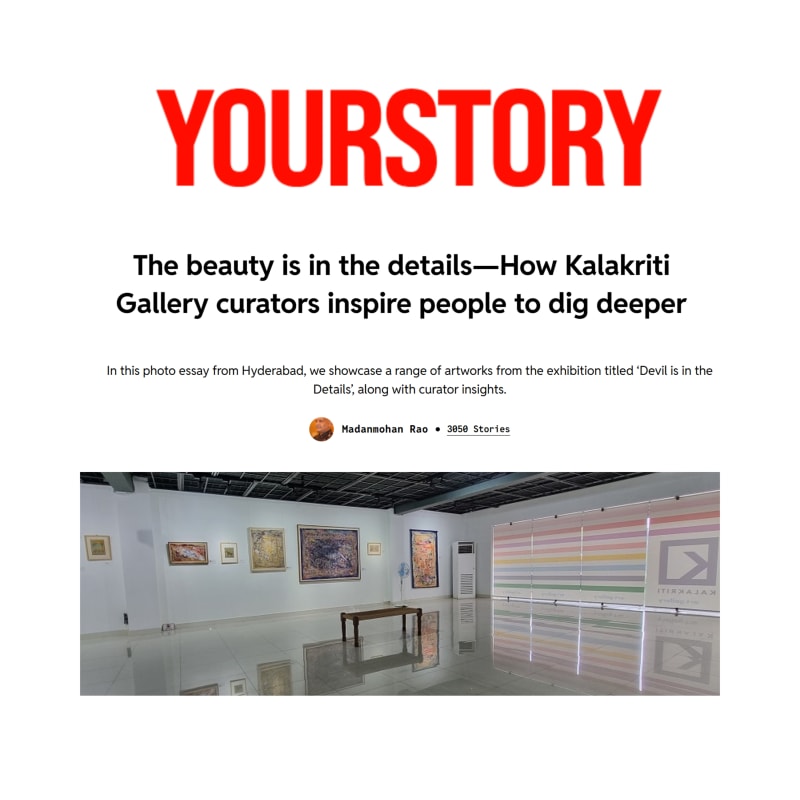A showcase of miniature artworks was recently featured at Kalakriti Art Gallery in Hyderabad. Titled Devil is in the Details, it was curated by Supriya Lahoti Gandhi and Jayesh Mathur.
“We wanted to explore how the miniature painting tradition continues to shape the imagination of artists today. For this show, we selected artists who, in very different ways, are inspired by this tradition—some through technique, others through ideas, themes, motifs or style and compositions,” Supriya Lahoti Gandhi tells YourStory.
Placing contemporary works alongside classical miniatures has an interesting effect. “The exhibition makes visible what is retained, what is transformed, and what acquires entirely new meaning in translation,” she adds.
The curators selected a range of artists who work across different media. They engage with the miniature in obvious and not-so-obvious ways.
The artist lineup features Divya Pamnani, Gargi Chandola, Gopa Trivedi, Keerti Pooja, Meghna Singh Patpatia, Parth Kothekar, Rajnish Chhanesh, Raka Panda, Rayana Giridhar Gowd, Sachin Shankar, Sangam Vankhade, and Viraj Khanna.
“The title of the exhibition comes from the idea that detail is never secondary—it is central to meaning. In Indian miniatures, details carry mood, emotion and narrative. They guide the viewer into worlds that are both intimate and expansive,” Gandhi explains.
The show invites the viewers to look deeper and discover the beauty in details. “Look again and you might notice something you had not seen before,” she suggests.
“The detail-oriented contemporary works, alongside antiquity, have the present and the past in conversation. The display was done with paintings placed next to each other having a similarity, difference or relation for the viewer to spot,” she describes.
The curators’ approach was to showcase the breadth of influence that miniatures have on contemporary art. “Nothing is ever created in isolation. This exhibition became a study into how our rich history and visual culture affect the present—its imagery and imagination,” Gandhi enthuses.
The curators asked: What aspects are carried forward? What gets modified? What gets omitted? What new possibilities emerge when artists reinterpret this legacy?
Based on these perspectives, the artists and artworks were chosen to represent a spectrum of practices. “They include painting, textile, papercut and metalwork. Each highlights a different facet of this continuing dialogue,” she explains.
One of the biggest challenges curators face is striking a balance between scholarship and accessibility. “As curators, we want to remain true to rigorous research while ensuring that exhibitions are engaging and meaningful for all audiences, not just specialists,” Jayesh Mathur adds.
“This exhibition was especially challenging as we were showcasing a past tradition alongside contemporary works. Making the two talk to each other and transition seamlessly was a challenge,” he admits.
Moreover, the classical miniatures had to be identified and brought together. “This took tremendous search and thought,” he recalls.
The curators were genuinely overwhelmed by the positive response to their exhibition. “This showcase is one of the rare shows in Hyderabad that has featured the old and the new together. This juxtaposition and context setting were appreciated,” Mathur proudly says.
Some visitors even took the time to communicate to the gallery team via email, appreciating that an exhibition like this had come to Hyderabad. The curators have a message for the audience as well.
“The exhibition is an invitation to look closer. We hope the exhibition encourages viewers to slow down and pay attention. We would like them to discover and ponder about our collective visual vocabulary and where motifs and ideas are drawn from,” Mathur suggests.
“We also hope that more audiences in the city engage with art. Visiting a gallery is not only about buying art,” he adds.
Art can spark curiosity. “Art can begin a new dialogue or even inspire you. That kind of engagement is exactly what we hoped to nurture through this exhibition,” Mathur signs off.
Now what have you done today to pause in your busy schedule and harness your creative side for a better world?
(All photographs taken by Madanmohan Rao on location at Kalakriti Art Gallery.)

